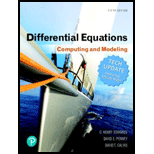
Concept explainers
(a)
Program Description: Purpose of the problem is to obtain the approximate values of
(a)
Explanation of Solution
Given information:
The differential problem is
The exact solution of the differential equation is
The two step size is
Calculation:
The differential problem can be represented as,
The Euler’s formula for
The Euler’s formula for
Substitute 0 for
Substitute 0 for
Substitute 0 for
Substitute 0 for
Substitute 1 for
Substitute 1 for
Substitute
Substitute
Therefore, the value of
Conclusion:
Thus, the approximate values of
(b)
Program Description: Purpose of the problem is to find the approximate values of
(b)
Explanation of Solution
Given information:
The differential problem is
The exact solution of the differential equation is
The two step size is
Calculation:
The improved Euler’s formula for predicators
The improved Euler’s formula for predicators
Substitute 0 for
Substitute 0 for
Substitute 0 for
Substitute 0 for
The improved Euler’s formula for correctors is shown below.
The improved Euler’s formula for correctors
Substitute 0 for
Substitute 0 for
Substitute 0 for
Substitute 0 for
Therefore, the value of
Conclusion:
Thus, the approximate values of
(c)
Program Description: Purpose of the problem is to find the approximate values of
(c)
Explanation of Solution
Given information:
The differential problem is
The exact solution of the differential equation is
The two step size is
Calculation:
The Runge-Kutta iteration formulas are shown below.
The Runge-Kutta iteration formulas are shown below
The value of
The value of
Substitute 0 for
Substitute 0 for
Substitute 0 for
Substitute 0 for
Substitute 0 for
Substitute 0 for
Substitute 0 for
Substitute 0 for
Substitute
Substitute
The exact solution
The exact solution
It can be observed that the Runge-Kutta method is more closes to the exact solution of the differential equation.
Conclusion:
Thus, the approximate values of
Want to see more full solutions like this?
Chapter 4 Solutions
Differential Equations: Computing And Modeling (tech Update) (5th Edition)
- Solve the given problems A and Barrow_forwardGive an example with solution of linear equation to the course of computer science.arrow_forwardConsider the function as given. (a) Use a computer algebra system to graph the function and use the graph to approximate the critical numbers visually. (b) Use a computer algebra system to find f′ and approximate the critical numbers. Are the results the same as the visual approximation in part (a)? Explain.arrow_forward
- 2. Heat conduction in a square plate Three sides of a rectangular plate (@ = 5 m, b = 4 m) are kept at a temperature of 0 C and one side is kept at a temperature C, as shown in the figure. Determine and plot the ; temperature distribution T(x, y) in the plate. The temperature distribution, T(x, y) in the plate can be determined by solving the two-dimensional heat equation. For the given boundary conditions T(x, y) can be expressed analytically by a Fourier series (Erwin Kreyszig, Advanced Engineering Mathematics, John Wiley and Sons, 1993):arrow_forwardDetermine the drag coefficient c needed for a parachutist of mass m=68.1kg to have a velocity of 40m/s after free-falling for time t=10s. Note: The acceleration due to gravity is 9.8m/s2. Use the Regula Falsi methodarrow_forwardfind the general solution to the following differential equation by using VARIATION OF PARAMETER method. y''+4y'+5y=e-2xsecxarrow_forward
- 1. Determine the equation of the line through the given point (a) parallel and (b) perpendicular to the given line Given: Point: ( -1,-4) Line: 4x-2y=3 2. Draw the line 4x-2y=3 and your answer for letter (a) in problem number 1 3. Draw the line 4x-2=3 and your answer for letter (b) in problem number 1 4. a2x-7ay+5a=0 Reduce the given equation to (a) intercept form (b) slope-intercept form A is the last two digit of your ID number, for example your ID number 20201000111, then (a) is 11 hence your equation would be 22x-77y+55=0arrow_forwardDiscuss the requirement for numerical approximation of various equation solutions.arrow_forwardSolve problems 1 and 2arrow_forward
 Operations Research : Applications and AlgorithmsComputer ScienceISBN:9780534380588Author:Wayne L. WinstonPublisher:Brooks Cole
Operations Research : Applications and AlgorithmsComputer ScienceISBN:9780534380588Author:Wayne L. WinstonPublisher:Brooks Cole
